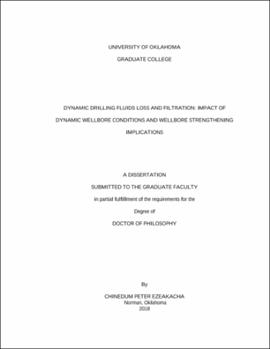| dc.description.abstract | Lost circulation (drilling fluid loss) and mud filtration have been investigated over the years because they lead to non-drilling time (NDT) and increase the overall well cost. It is usually the first source of damage to the formation among other processes such as completions, workover, and hydraulic fracturing. There are several field solutions that have been proffered and these are grouped under remedial and preventative solutions. Investigation of drilling fluid loss is mostly done via experimental studies with several types of setups, fluid formulations, and porous media. However, lithology complexities, geothermal and geochemical effects, and other wellbore drilling dynamics continue to push the boundaries to develop better preventative strategies.
In this research, pore and fracture-scale dynamic drilling fluid loss are investigated and the results are used in characterizing filter cake wellbore strengthening. A comprehensive theoretical study was first conducted to provide the technical background required to address the research hypotheses. This was followed by experimental investigations whose results show that temperature, rotary speed, fracture width and orientation, rock permeability and porosity, lost circulation material (LCM) type, and LCM concentration are critical factors that significantly influence dynamic drilling fluid loss and filtration. Scanning electron microscope (SEM) images and elemental maps of selected samples showed near-wellbore pore plugging by granular LCM. Granular and fibrous LCM concentration thresholds were established based on the maximum anticipated operating conditions. The result from testing the filter cake stability (a measure of the filter cake wellbore strengthening process in fractures) was 67% successful.
Statistical design and analysis were used for pre-experimental and post-experimental evaluations. The results revealed the significance of the single and multiple effects of the factors investigated. The empirical models from post-experimental studies showed good predictability of dynamic fluid loss and filtration with considerable high R2 values. To enhance the predictability of mud filtration and fill the gaps in an empirical modeling approach, a robust mechanistic model for dynamic drilling fluid filtration was developed and tuned based on laboratory results. The model revealed an average relative error that is less than 5 % in estimating dynamic mud filtration. Geomechanical and in-situ stress implications were investigated. The results showed that the rock permeability and filter cake permeability profiles largely control the changes in wellbore hoop stress profile.
The novelty in this study is in the use of thick-walled cylindrical sandstones, limestones, chalks, and fracture slots to profile dynamic drilling fluid loss and filtration of different fluid designs. Different pressures, temperatures, and drillpipe rotary speeds were combined to simulate dynamic wellbore conditions under which fluid/filtrate loss, filter cake evolution, and filter cake plastering effect can occur. The approaches in the research can be used in drilling fluid design for minimizing fluid loss, wellbore strengthening application, and selection of operating conditions. | en_US |
